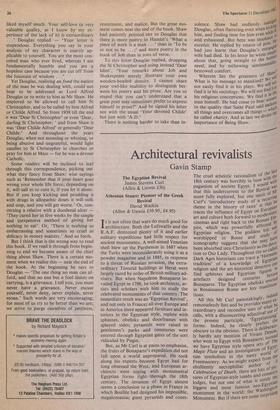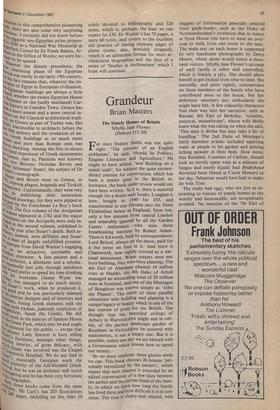Architectural revivalists
Gavin Stamp
The Egyptian Revival James Stevens Curl (Allen & Unwin £30)
Athenian Stuart: Pioneer of the Greek Revival David Watkin (Allen & Unwin £10.95, £4.95) Tt is not often that wars do much good for 1-architecture. Both the Luftwaffe and the R.A.F. destroyed plenty of it and earlier military expeditions had little respect for ancient monuments. A well-aimed Venetian shell blew up the Parthenon in 1687 when the Turks were inconsiderately using it as a powder magazine and in 1885, in response to a threat of Russian invasion, the extra- ordinary Timurid buildings at Herat were largely razed by order of British military ad- visers. But when Napoleon Bonaparte in- vaded Egypt in 1798, he took architects, ar- tists and scholars with him to study the celebrated monuments of that country. The immediate result was an 'Egyptian Revival', and not only in France; all over Europe and in America there appeared furniture and in- teriors in the Egyptian style, replete with. sphinxes, obelisks and doorframes with splayed sides; pyramids were raised in gentlemen's parks and cemeteries were entered through Egyptian gates of the sort ridiculed by Pugin.
But, as Mr Curl is at pains to emphasise, the fruits of Bonaparte's expedition did not fall upon a world unprepared. He took along his experts because Egypt had for long obsessed the West, and European ar- chitects were toying with monumental Egyptian forms right through the 18th century. The invasion of Egypt almost seems a conclusion to a phase in France in which Boullee had designed his impossible, megalomaniac giant pyramids and cones.
The cruel atheistic rationalism of the la: 18th century was horribly in tune with to, paganism of ancient Egypt. 1 would wis" as that this undercurrent to the Revival glo. more fully explored, but one merit of Curl's 'introductory study of a recurrill theme in the history of taste' is that arib traces the influence of Egypt on Eawlf„.c
art and culture both forward to mod .
ern,is" cinemas and right back to the Roman 11y pire, which was powerfully affectea , Egyptian religion. The goddess Isis worshipped in Rome and studY v°e iconography suggests that she may ha been absorbed into Christianity as the devcerei tion to Our Lady. Throughout the so-eall ,c Dark Ages historians can trace a `Herale.tapi tradition' of a knowledge of Egypt! n religion and the art-historical detective can find sphinxes and Egyptian figuresf° le artefacts designed centuries he„rei Bonaparte. The Egyptian obelisks erect • in Renaissance Rome are key manifesta- tions. All this Mr Curl painstakinglY, remorselessly lists and he provides InarlY ; traordinary and recondite uses of what hf calls, with a disconcerting adjectival use O, the present participle, `Egyptianising forms. Indeed, he clearly prefers the obscure to the obvious. There is deliberate- ly hardly any mention of Vivant Denorld : neo-EgYPtIv 01 _ee a who went to Egypt with Bonaparte; inst i we have Egyptian style opera sets of n Magic Flute and an investigation of Egg; tian symbolism in the nasty world Freemasonry. As we might expect from tit; ebulliently necrophiliac author of . Celebration of Death, there are lots of pic- tures of Egyptian-style tombs and cemeter! lodges, but not one of what is surely biggest and most famous monument in the world: the Washington Monument. But if there are some surprisiag C:IliSsiOns in this comprehensive pioneering 'intidY, there are also some very surprising oilkusions. I certainly did not know before eti'.ue gigantic neo-Egyptian pylon propos- 1920 as a National War Memorial at ch'.'ve Park Corner by Sir Frank Baines, Ar- ialtect to the Office of Works; we were for- late to be spared. • Whatever the distant precedents, the Re°3vi! interesting phase of the Egyptian botval was surely in the early 19th century, t8 Was
fact remains that, whatever the im-
,_atnee of Egypt in European civilisation, ilaebs".'-gYptian buildings are always a little ptirci, whether the extant Egyptian House ter enzance or the (sadly mutilated) Car- beelts1 Factory in Camden Town. Greece has flop a More potent and a more central in- tio,,nce on the Classical architectural tradi- ", Yet Greece as part of Turkey was, like lagtYP, it, inaccessible to architects before the 'ate 18 century and the revelation of an- aos-t` Greek buildings as so much more al ere and pure than Roman ones. was ,inost IIrst h Shocking. Among the first to secure lih nuand experience of Greek monuments were-reece, that is; Paestum was known) 1a111- two Britons: Nicholas Revett and Watr,; 'Athenian' Stuart, the subject of Dr
's monograph.
17sitlakrt and Revett went to Greece, in blire'„uraviog plague, brigands and Turkish ilow'cracy. Unfortunately, they were very ti in publishing their meticulous the red drawings, for they were pipped at Of1.7tt by the Frenchman Le Roy's book ofA '°. The first volume of the Antiquities 410,,„tiletis appeared in 1762 and 'the major tints on the Acropolis were only in- 17agecit_in the second volume, published in tne Year after Stuart's death. Both ar- was-`ts, indeed, were diffident and Stuart ,a,,..inao of largely unfulfilled promise. text7lIerge5 from David Watkin's engaging drin.,Las an attractive, unreliable and goZen character. A fine painter and a t architect, a dilettante and a scholar, epeatedly lost jobs through indolence u,ithcluld prefer to spend his time drinking hisworkmen (James Wyatt was @Lit 4,r, but managed to do much more). was 'Mart's work, when he produced it, a good and he was particularly talented flo.: interior designer and of interiors and AhLture, fusing Greek elements with the Psty, le (Adam, jealously suspicious of ,Illtieh i et"cm, hated the Greek). He did 0y th work in the interior of Spencer House to b: Green Park, which may be and ought the restored for the public — except that stuagresent Lady Spenceris busy selling kriotrth's furniture, amongst other things. Whir:L..1er interior, of great delicacy, with Of 6" Stuart was involved was the Chapel Stbenwich Hospital. We do not find in trA7 ni S essentially Georgian work the kevi austerity of the full-blooded Greek but he was an architect well worth ti te:tigating and he has been very fortunate 110sographer. Dobi."', these books come from the same 4401)sn,ter. Mr Curl's has 203 illustrations "8 Pages, including no less than 19
solely devoted to bibliography and 524 notes, which is, perhaps, the least we can expect for £30. Dr Watkm's has 70 pages, a mere 60 notes, and reverts to the excellent old practice of having separate pages of plates (some, alas, brutishly cropped), which is an admirable format for short ar- chitectural biographies and the first of a series of 'Studies in Architecture' which I hope will continue.











































 Previous page
Previous page